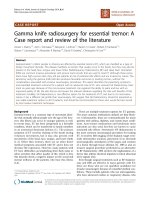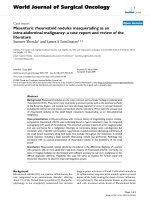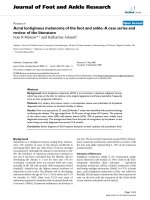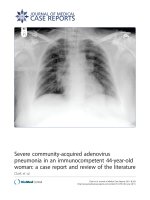Báo cáo y học: " Mycosis fungoides bullosa: a case report and review of the literature" pps
Bạn đang xem bản rút gọn của tài liệu. Xem và tải ngay bản đầy đủ của tài liệu tại đây (497.23 KB, 3 trang )
CAS E REP O R T Open Access
Mycosis fungoides bullosa: a case report and
review of the literature
Hermann Kneitz
*
, Eva-B Bröcker, Jürgen C Becker
Abstract
Introduction: Mycosis fungoides, the most common type of cutaneous T-cell lymphoma, can manifest in a variety
of clinic al and histological forms. Bulla formation is an uncommon finding in mycosis fungoides and only
approximately 20 cases have been reported in the literature.
Case presentation: We present a case of rapidly progressive mycosis fungoides in a 68-year-old Caucasian man
who in itially presented with erythematous plaques characterised by blister formation.
Conclusion: Although mycosis fungoides bullosa is extremely rare, it has to be regarded as an imp ortant clinical
subtype of cutaneous T-cell lymphoma. Mycosis fungoides bullosa represents a particularly aggressive form of
mycosis fungoides and is associated with a poor prognosis. The rapid disease progression in our patient confirms
bulla formation as an adverse prognostic sign in cutaneous T-cell lymphoma.
Introduction
Mycosis fungoides, the most common type of cutaneous
T-cell lymphoma, can manifest in a variety of clinical
and histological forms, but blistering is not a feature
normally associated with the condition. Indeed, of the
many variants that have been reported in the literature,
appr oximately 20 cases of the bullous varia nt have been
described.
Case presentation
A 68-year-old Caucasian man presented for evaluation
of two indurated erythemato us plaques (9 × 8 cm and 8
× 5 cm) on his left thigh (Figure 1A); within these pla-
ques, intact bullae and erosions were present. The con-
dition had persisted for several years with a slow growth
in diameter and thickness despite topical therapy with
potent steroids. Notably, the patient reported several
fugacious episodes of blistering within and in the vici-
nity of these plaques; these episodes had occurred with
increasing frequency over the preceding months. The
general examination results were otherwise unremark-
able. In particular, neither lymphadenopathy nor
organomegaly were present. Histological examination of
these lesions revealed subcorneal and intra-epidermal
bullae accompanied by infiltra tes of atypica l lympho-
cytes. The latter were characterised by a marked
epidermotropism and the formation of Pautrier micro-
abscesses (Figure 1B). Immunohistochemical analysis
revealed the infiltrate to be predominantly T cells
(CD3+, CD20-). Direct (Figure 1C) and indirect immu-
nofluorescence as well as bacterial and fungal cultures
were negative.
Initial treatment of our patient with electron beam
irradiation led to complete clearance, but after 1 year,
generalised erythematous plaques of mycosis fungoides
bullosa appeared on his trunk and extremities without
lymph node and visceral involvement. Further electron
beam irradiation was carried out.
Discussion
The most common causes of acquired bulla formation
on inflamed skin areas are acute contact dermatitis as
well as infections with Staphylococci,orvirusesofthe
herpes group. Bullous lichen planus or bullous lupus
erythematosus are rare diseases, whereas bullous
pemphigoid is the most common autoimmune bullous
disorder [1].
In mycosis fungoides, bulla formation is very uncom-
mon. Approximately 20 cases have been reported in th e
literature [2,3]. Mycosis fungoides bullosa is largely
restricted to older patients without predominance of
* Correspondence:
Department of Dermatology, Julius-Maximilians University, Josef-Schneider-
Str. 2, 97080 Wuerzburg, Germany
Kneitz et al. Journal of Medical Case Reports 2010, 4:78
/>JOURNAL OF MEDICAL
CASE REPORTS
© 2010 Kneitz et al; li censee BioMed Central Ltd. This is an Open Access article distributed under the terms of the Creative Commons
Attribution License ( which perm its unrestrict ed use, distribution, and reproduction in
any medium, provided the original work is properly cited.
gender. Predilection sites are the trunk and limbs . Vesi-
cles and blisters usually arise in typical plaques and
tumours but also in normal-appearing skin [2,4].
An association with concomitant bullous pemphigoid
or previous treatment with psoralen UVA photoche-
motherapy has been reported [5]. Bowman et al.
proposed the following criteria fo r diagnosis of mycosis
fungoides bullosa [2]: (1) clinically apparent vesiculobul-
lous lesions; (2) typical histologic features of mycosis
fungoides (atypical lymphoid cells, epidermotropism,
Pautrier’s microabscesses) with intra-epidermal or sube-
pidermal blisters; (3) negative immunofluorescence
ruling out concomitant autoimmune bullous diseases;
and (4) negative evaluation for other possible causes of
vesiculobullous lesions (for example, medications,
bacterial or viral infection, porphyria, phototherapy).
The pathological mechanism underlying blister forma-
tion has not been elucidated. Confluence of Pautrier’s
microabscesses in mycosis fungoides lesions may lead to
intra-epidermal bulla forma tion [6]. Alternatively, prolif-
eration of neoplastic lymphocytes may result in a loss of
coherence between basal keratinocytes and basal lamina
[7] or the cohesion of keratinocytes m ay be affected by
the release of lymphokines by atypical lymphocytes [8].
Conclusions
Although mycosis fungoides bullosa is ex tremely rare, it
has to be regarded as an important clinical subtype of
cutaneous T-cell lymphoma. Myc osis fungoides bullosa
represents an especially aggressive form of mycosi s fun-
goides associated with a poor prognosis. Approximately
50% of patients die within 1 year after the appearance of
the blistering of the lymphoma plaques [1,9].
Consent
Written informed consent was obtained from the patient
for publicatio n of this case report and any accompany-
ing images. A copy of the written c onsent is avail able
for review by the Editor-in-Chief of this journal.
Authors’ contributions
All authors contributed in the management of the patient, writing of the
manuscript and reviewing the literature. All authors read and approved the
final manuscript.
Competing interests
The authors declare that they have no competing interests.
Received: 30 March 2008
Accepted: 3 March 2010 Published: 3 March 2010
Figure 1 Mycosis fungoides presentation, and histolo gical and immunohistochemical examinations. (a) Bullous lesions are present on
two indurated erythematous plaques on the left thigh. (b) Histopathologic section showing subcorneal and intra-epidermal bullae accompanied
by infiltrates of atypical lymphocytes. (c) Direct immunofluorescence examination reveals the absence of immunoreactants both within the
epidermis and at the dermo-epidermal junction.
Kneitz et al. Journal of Medical Case Reports 2010, 4:78
/>Page 2 of 3
References
1. Bertram F, Bröcker EB, Zillikens D, Schmidt E: Prospective analysis of the
incidence of autoimmune bullous disorders in Lower Franconia,
Germany. J Dtsch Dermatol Ges 2009, 13:379-387.
2. Bowman PH, Hogan DJ, Sanusi ID: Mycosis fungoides bullosa: report of a
case and review of the literature. J Am Acad Dermatol 2001, 45:934-939.
3. Gantcheva M, Lalova A, Broshtilova V, Negenzova Z, Tsankov N: Vesicular
mycosis fungoides. J Dtsch Dermatol Ges 2005, 3:898-900.
4. Ho KK, Browne A, Fitzgibbons J, Carney D, Powell FC: Mycosis fungoides
bullosa simulating pyoderma gangrenosum. Br J Dermatol 2000,
142:124-127.
5. Patterson J, Ali M, Murray J, Hatra T: Bullous pemphigoid: occurrence in
patient with mycosis fungoides receiving PUVA and topical mustard
therapy. Int J Dermatol 1985, 24:173-176.
6. Kazakov DV, Burg G, Kempf W: Clinicopathological spectrum of mycosis
fungoides. J Eur Acad Dermatol Venereol 2004, 18:397-415.
7. Konrad K: Mycosis fungoides bullosa. Lymphoproliferative Diseases of the
Skin New York: Springer VerlagChristophers E, Goos M 1979, 157-162.
8. Kartsonis J, Brettschneider F, Weissmann A, Rosen L: Mycosis fungoides
bullosa. Am J Dermatopathol 1990, 12:76-80.
9. McBride S, Dahl M, Slater D, Sviland L: Vesicular mycosis fungoides. Br J
Dermatol 1998, 138:141.
doi:10.1186/1752-1947-4-78
Cite this article as: Kneitz et al.: Mycosis fungoides bullosa: a case report
and review of the literature. Journal of Medical Case Reports 2010 4:78.
Submit your next manuscript to BioMed Central
and take full advantage of:
• Convenient online submission
• Thorough peer review
• No space constraints or color figure charges
• Immediate publication on acceptance
• Inclusion in PubMed, CAS, Scopus and Google Scholar
• Research which is freely available for redistribution
Submit your manuscript at
www.biomedcentral.com/submit
Kneitz et al. Journal of Medical Case Reports 2010, 4:78
/>Page 3 of 3









